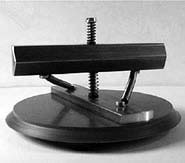Noise put to work

This converts noise to one-way spin. <br>©AIP/Y.Zolotaryuk <br>
Random vibrations can generate rotation.
A simple top converts foghorn noise to one-way spin. The device raises the hope that useful energy could be collected from ambient sounds. Normally, random vibrations, which physicists and engineers call noise, produce useless random motion. You can’t move a cart from A to B by shoving it randomly in every direction.
But in the new device, made by Yaroslav Zolotaryuk of the Technical University of Denmark in Lyngby and colleagues, a flat plate encounters more friction when it spins in one direction than in the other, meaning it always rotates predictably1.
The top is surprisingly simple, like something from a child’s construction set. Two horizontal rectangular plates are connected by a set of springs. A vertical rod in the centre of the lower plate passes through the centre of the upper plate, and two springs threaded onto this rod hold the plates apart. Two other springs link the ends of the upper and lower plates. The upper plate is rotated relative to the lower one, giving the entire structure a screw-like twist.
The direction of this twist determines the direction of rotation. When the upper plate is given a series of taps from random directions, the lower plate rotates in a single direction, pulling the rest of the device with it.
The twist doesn’t actually cause this biased rotation. If the springs were replaced with rigid rods, for instance, random taps would produce random rotation in both directions. The bias occurs because there is more friction between the lower plate and the surface on which it sits when the upper plate is pressed down than when it is pressed up. The springs convert this difference into a preference to rotate in just one direction.
On the bias
It has been known for about 90 years that noise can be used to induce directional motion. The trick is, as in the case of this latest device, to set up some kind of bias in one direction.
During the 1990s, physicists began to study ’brownian ratchets’. In these models, random pushes – such as a dust particle receives from colliding air molecules, which normally induce erratic or ’brownian’ motion – propel a particle in a predictable direction.
In a brownian ratchet, bias is introduced by having the particle move over a set of sawtooth ridges, which slope more gently in one direction than in the other.
References
- Norden, B., Zolotaryuk, Y., Christiansen, P.L. & Zolotaryuk, A.V. Ratchet device with broken friction symmetry. Applied Physics Letters, 80, 2601 – 2603, (2002).
Media Contact
All latest news from the category: Physics and Astronomy
This area deals with the fundamental laws and building blocks of nature and how they interact, the properties and the behavior of matter, and research into space and time and their structures.
innovations-report provides in-depth reports and articles on subjects such as astrophysics, laser technologies, nuclear, quantum, particle and solid-state physics, nanotechnologies, planetary research and findings (Mars, Venus) and developments related to the Hubble Telescope.
Newest articles

First-of-its-kind study uses remote sensing to monitor plastic debris in rivers and lakes
Remote sensing creates a cost-effective solution to monitoring plastic pollution. A first-of-its-kind study from researchers at the University of Minnesota Twin Cities shows how remote sensing can help monitor and…

Laser-based artificial neuron mimics nerve cell functions at lightning speed
With a processing speed a billion times faster than nature, chip-based laser neuron could help advance AI tasks such as pattern recognition and sequence prediction. Researchers have developed a laser-based…

Optimising the processing of plastic waste
Just one look in the yellow bin reveals a colourful jumble of different types of plastic. However, the purer and more uniform plastic waste is, the easier it is to…


